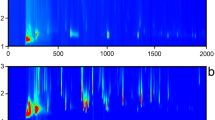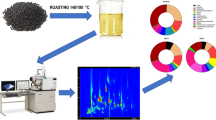Abstract
Lipid oxidation leads to the formation of volatile compounds involved in the aroma of edible oils. Specifically, the use of rapeseed oil for frying causes an emission of off-flavors, characterized by a fishy odor. The aim of the present study was to identify the compounds present in the headspace of degraded rapeseed oil, and in particular, to determine the presence of six compounds commonly considered as responsible for the fishy odor: 1-penten-3-one, 1-octen-3-one, (Z)-4-heptenal, (E,Z)-2,6-nonadienal, (E,Z)-2,4-heptadienal, and (E,Z,Z)-2,4,7-decatrienal. Because of the complexity of the headspace of degraded oils, comprehensive two-dimensional gas chromatography (GC × GC) coupled to mass spectrometry (MS) was the technique of choice, providing a suitable separation power and sensitivity. The extraction of volatile compounds was performed by headspace solid-phase microextraction (HS-SPME). First, three different column sets were evaluated (apolar–polar, polar–apolar, apolar–medium polar) by means of a mixture of 33 standards representative of those involved in the aroma of edible oils. The apolar–polar column set was considered as providing a satisfactory separation with an excellent occupation of the separation space. The developed method was then applied to a real sample of heated rapeseed oil and 110 compounds were identified, which included the six compounds of interest. The contribution of GC × GC in terms sensitivity was evaluated by means of a comparison with analyses in 1D-GC. Finally, the concentrations of the compounds involved in the fishy odor in heated oil were determined.



Similar content being viewed by others
References
Choe E, Min DB (2006) Mechanisms and factors for edible oil oxidation. Compr Rev Food Sci F 5(4):169–186
Jeleń H, Mildner-Szkudlarz S, Jasińska I, Wąsowicz E (2007) A headspace–SPME–MS method for monitoring rapeseed oil autoxidation. J Am Oil Chem Soc 84(6):509–517
Richards A, Wijesundera C, Salisbury P (2005) Evaluation of oxidative stability of canola oils by headspace analysis. J Am Oil Chem Soc 82(12):869–874
Kochhar SP (1996) Oxidative pathways to the formation of off-flavours. In: Saxby MJ (ed) Food taints and off-flavours. Springer, US, pp 168–225
Belitz HD, Grosch W, Schieberle P (2009) Food chemistry, 4th edn. Springer, Berlin
Gunstone FD, Harwood JL, Dijkstra AJ (2007) The lipid handbook, 3rd edn. CRC Press, Boca Raton
Harris WS, Varvel SA, Pottala JV, Warnick GR, McConnell JP (2013) Comparative effects of an acute dose of fish oil on omega-3 fatty acid levels in red blood cells versus plasma: implications for clinical utility. J Clin Lipidol 7(5):433–440
Baghai TC, Varallo-Bedarida G, Born C, Haefner S, Schüle C, Eser D, Rupprecht R, Bondy B, von Schacky C (2011) P02-09—major depression, cardiovascular risk factors and the Omega-3 index. Eur Psychiat 26(1):603
Karahadian C, Lindsay RC (1989) Evaluation of compounds contributing characterizing fishy flavors in fish oils. J Am Oil Chem Soc 66(7):953–960
Josephson DB, Lindsay RC, Stuiber DA (1983) Identification of compounds characterizing the aroma of fresh whitefish (Coregonus clupeaformis). J Agr Food Chem 31(2):326–330
Hartvigsen K, Lund P, Hansen LF, Holmer G (2000) Dynamic headspace gas chromatography/mass spectrometry characterization of volatiles produced in fish oil enriched mayonnaise during storage. J Agric Food Chem 48(10):4858–4867
Bicchi C, Cagliero C, Rubiolo P (2011) New trends in the analysis of the volatile fraction of matrices of vegetable origin: a short overview. A review. Flavour Frag J 26(5):321–325
Croissant AE, Watson DM, Drake MA (2011) Application of sensory and instrumental volatile analyses to dairy products. Annu Rev Food Sci Technol 2:395–421
Mildner-Szkudlarz S, Jeleń HH, Zawirska-Wojtasiak R, Wąsowicz E (2003) Application of headspace—solid phase microextraction and multivariate analysis for plant oils differentiation. Food Chem 83(4):515–522
Cavalli JF, Fernandez X, Lizzani-Cuvelier L, Loiseau AM (2003) Comparison of static headspace, headspace solid phase microextraction, headspace sorptive extraction, and direct thermal desorption techniques on chemical composition of french olive oils. J Agr Food Chem 51(26):7709–7716
Temime SB, Campeol E, Cioni PL, Daoud D, Zarrouk M (2006) Volatile compounds from Chétoui olive oil and variations induced by growing area. Food Chem 99(2):315–325
Dallüge J, Beens J (2003) Brinkman UAT (2003) Comprehensive two-dimensional gas chromatography: a powerful and versatile analytical tool. J Chromatogr A 1000(1–2):69–108
Adahchour M, van Stee LLP, Beens J, Vreuls RJJ, Batenburg MA (2003) Brinkman UAT (2003) Comprehensive two-dimensional gas chromatography with time-of-flight mass spectrometric detection for the trace analysis of flavour compounds in food. J Chromatogr A 1019(1–2):157–172
Kiefl J, Cordero C, Nicolotti L, Schieberle P, Reichenbach SE, Bicchi C (2012) Performance evaluation of non-targeted peak-based cross-sample analysis for comprehensive two-dimensional gas chromatography–mass spectrometry data and application to processed hazelnut profiling. J Chromatogr A 1243:81–90
Mondello L, Tranchida PQ, Dugo P, Dugo G (2008) Comprehensive two-dimensional gas chromatography-mass spectrometry: a review. Mass Spectrom Rev 27(2):101–124
de Geus H-J, Aidos I, de Boer J, Luten JB, Brinkman UAT (2001) Characterisation of fatty acids in biological oil samples using comprehensive multidimensional gas chromatography. J Chromatogr A 910(1):95–103
Hu W, Zhang L, Li P, Wang X, Zhang Q, Xu B, Sun X, Ma F, Ding X (2014) Characterization of volatile components in four vegetable oils by headspace two-dimensional comprehensive chromatography time-of-flight mass spectrometry. Talanta 129:629–635
Snow NH, Slack GC (2002) Head-space analysis in modern gas chromatography. TrAC Trend Anal Chem 21(9–10):608–617
Ha J, Seo DW, Chen X, Hwang JB, Shim YS (2011) Determination of hexanal as an oxidative marker in vegetable oils using an automated dynamic headspace sampler coupled to a gas chromatograph/mass spectrometer. Anal Sci Int J Jpn Soc Anal Chem 27(9):873–878
Zunin P, Boggia R, Lanteri S, Leardi R, De Andreis R, Evangelisti F (2004) Direct thermal extraction and gas chromatographic-mass spectrometric determination of volatile compounds of extra-virgin olive oils. J Chromatogr A 1023(2):271–276
Arthur CL, Pawliszyn J (1990) Solid phase microextraction with thermal desorption using fused silica optical fibers. Anal Chem 62(19):2145–2148
Zhang Z, Pawliszyn J (1993) Headspace solid-phase microextraction. Anal Chem 65(14):1843–1852
Jeleń HH, Obuchowska M, Zawirska-Wojtasiak R, Wa̧sowicz E (2000) Headspace solid-phase microextraction use for the characterization of volatile compounds in vegetable oils of different sensory quality. J Agr Food Chem 48(6):2360–2367
Guillen MD, Goicoechea E (2008) Formation of oxygenated α, β-unsaturated aldehydes and other toxic compounds in sunflower oil oxidation at room temperature in closed receptacles. Food Chem 111(1):157–164
Ma C, Ji J, Tan C, Chen D, Luo F, Wang Y, Chen X (2014) Headspace solid-phase microextraction coupled to gas chromatography for the analysis of aldehydes in edible oils. Talanta 120:94–99
Wardencki W, Michulec M, Curyło J (2004) A review of theoretical and practical aspects of solid-phase microextraction in food analysis. Int J Food Sci Tech 39(7):703–717
Peres F, Jeleń HH, Majcher MM, Arraias M, Martins LL, Ferreira-Dias S (2013) Characterization of aroma compounds in Portuguese extra virgin olive oils from Galega Vulgar and Cobrançosa cultivars using GC–O and GC × GC–ToFMS. Food Res Int 54(2):1979–1986
Wei F, Yang M, Zhou Q, Zheng C, Peng J-H, Liu C-S, Huang F-H, Chen H (2012) Varietal and processing effects on the volatile profile of rapeseed oils. LWT Food Sci Technol 48(2):323–329
Purcaro G, Cordero C, Liberto E, Bicchi C, Conte LS (2014) Toward a definition of blueprint of virgin olive oil by comprehensive two-dimensional gas chromatography. J Chromatogr A 1334:101–111
Giddings JC (1990) Use of multiple dimensions in analytical separations. In: Cortes HJ (ed) Multidimensional chromatography: techniques and applications. Marcel Dekker, New York, pp 1–28
Adam F, Bertoncini F, Coupard V, Charon N, Thiébaut D, Espinat D, Hennion M-C (2008) Using comprehensive two-dimensional gas chromatography for the analysis of oxygenates in middle distillates: i. Determination of the nature of biodiesels blend in diesel fuel. J Chromatogr A 1186(1–2):236–244
Torres Vaz-Freire L, Gomes da Silva MDR, Costa Freitas AM (2009) Comprehensive two-dimensional gas chromatography for fingerprint pattern recognition in olive oils produced by two different techniques in Portuguese olive varieties Galega Vulgar. Cobrançosa e Carrasquenha. Anal Chim Acta 633(2):263–270
Silva I, Rocha SM, Coimbra MA, Marriott PJ (2010) Headspace solid-phase microextraction combined with comprehensive two-dimensional gas chromatography time-of-flight mass spectrometry for the determination of volatile compounds from marine salt. J Chromatogr A 1217(34):5511–5521
Jespers S, Roeleveld K, Lynen F, Broeckhoven K, Desmet G (2015) Kinetic plots for gas chromatography: theory and experimental verification. J Chromatogr A 1386:81–88
Stoll DR, Wang X, Carr PW (2008) Comparison of the practical resolving power of one- and two-dimensional high-performance liquid chromatography analysis of metabolomic samples. Anal Chem 80(1):268–278
Gromadzka J, Wardencki W (2010) Static headspace sampling and solid-phase microextraction for assessment of edible oils stability. Chromatographia 71:S81–S86
Conflict of interest
The authors have no conflict of interest to declare.
Author information
Authors and Affiliations
Corresponding author
Rights and permissions
About this article
Cite this article
Sghaier, L., Cordella, C.B.Y., Rutledge, D.N. et al. Comprehensive Two-dimensional Gas Chromatography for Analysis of the Volatile Compounds and Fishy Odor Off-flavors from Heated Rapeseed Oil. Chromatographia 78, 805–817 (2015). https://doi.org/10.1007/s10337-015-2897-8
Received:
Revised:
Accepted:
Published:
Issue Date:
DOI: https://doi.org/10.1007/s10337-015-2897-8




